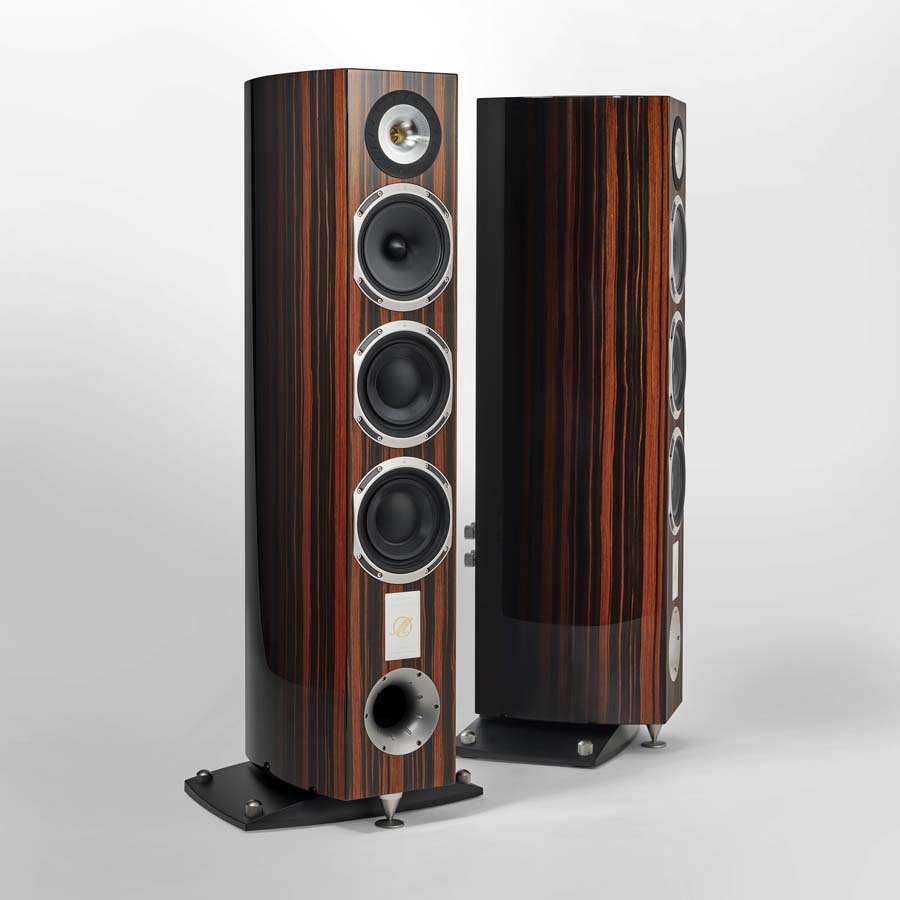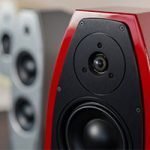TRIANGLE MAGELLAN CELLO 40TH ANNIVERSARY REVIEW
The second-largest in the limited-edition Magellan 40th Anniversary range, the 1.14 metres high, 39 kg Triangle Magellan Cello leaves nothing on the table when it comes to opulence. Does it offer a similarly rich listening experience? HiFi PiG’s Eric van Spelde finds out.
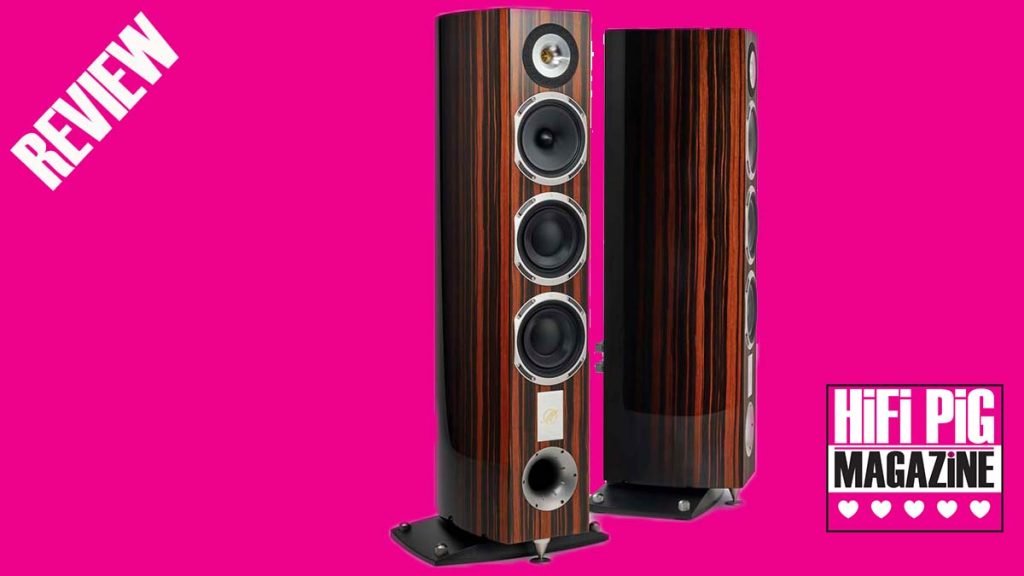
The Magellan 40th Anniversary range consists of three stereo loudspeakers and a centre speaker and sits at the top of a portfolio covering five levels of speakers as well as a line of subwoofers, and wireless and custom install speakers from the French brand. The series draws its inspiration from historic Triangle designs, particularly the Magellan Grand Concert from 2007 and each of the three models is limited to a production run of 500 pairs. Finished in Zebrano veneer covered with twelve coats of high gloss lacquer, the relatively slim columns with curved sides are certainly striking to look at. These are not cool, simple, Bauhaus or Scandinavian-inspired designs, but rather ooze opulence and craftsmanship like a Bentley´s interior, drawing favourable comments from everyone who saw them in our living room.
BUILD QUALITY AND FEATURES OF THE TRIANGLE MAGELLAN CELLO 40TH ANNIVERSARY
The first thing you ask yourself when a pair of 11,000-euro loudspeakers is being delivered to your front door – well the second thing after ´how do I get these inside and at their rightful place in the living room´ probably – is ´do I feel pampered, does it feel like I have something special here? ´ In this case, the answer is an unequivocal ´yes, I do´. The boxes in which the speakers come are well thought out, and the manufacturer made every effort to ensure the unboxing will not only go as smoothly as possible by providing ample instructions on the box – plus a referral to an online instruction video – but also to make it something of an event. Before extracting the actual speaker from its box, you first remove a smaller box, lined with the sort of high-density foam that professional quality spanner and ratchet sets tend to come in. In those two boxes (one per speaker), you´ll find a pair of cast aluminium base plates for the speakers, with all accessories for placement of the speakers in a lovely wooden box, a silk envelope containing the owner´s manual as well as a pair of white gloves and a polishing cloth to keep the woodwork in pristine condition. Fit and finish of our review pair were exemplary.
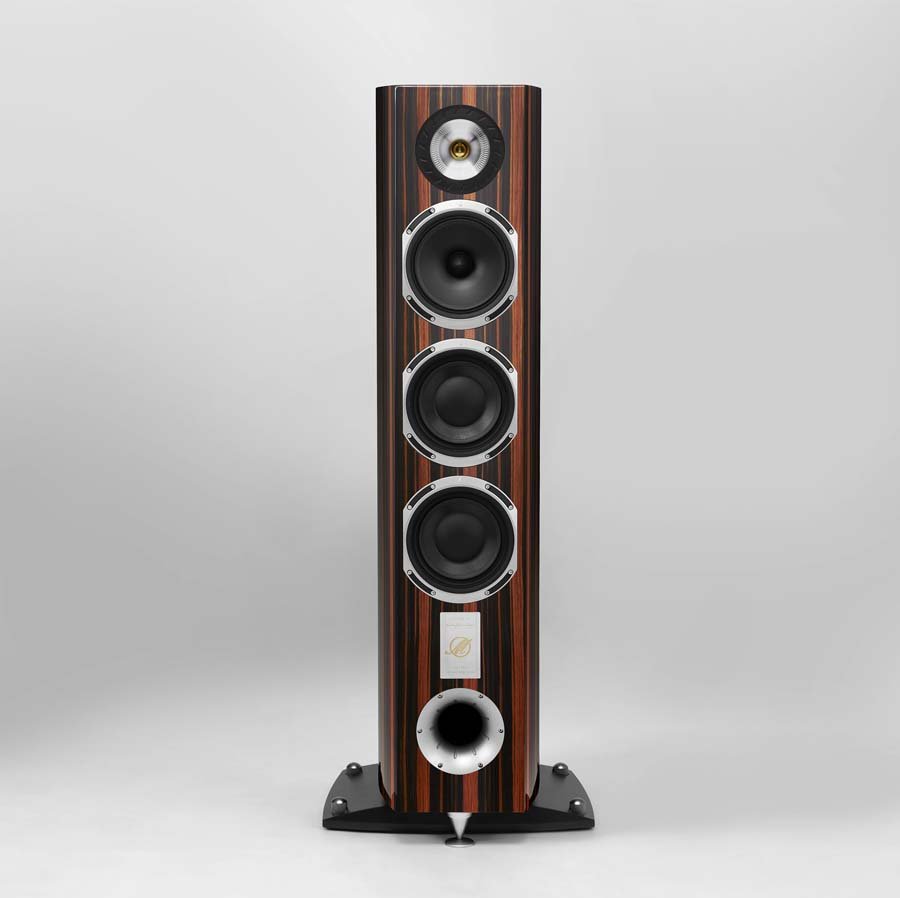
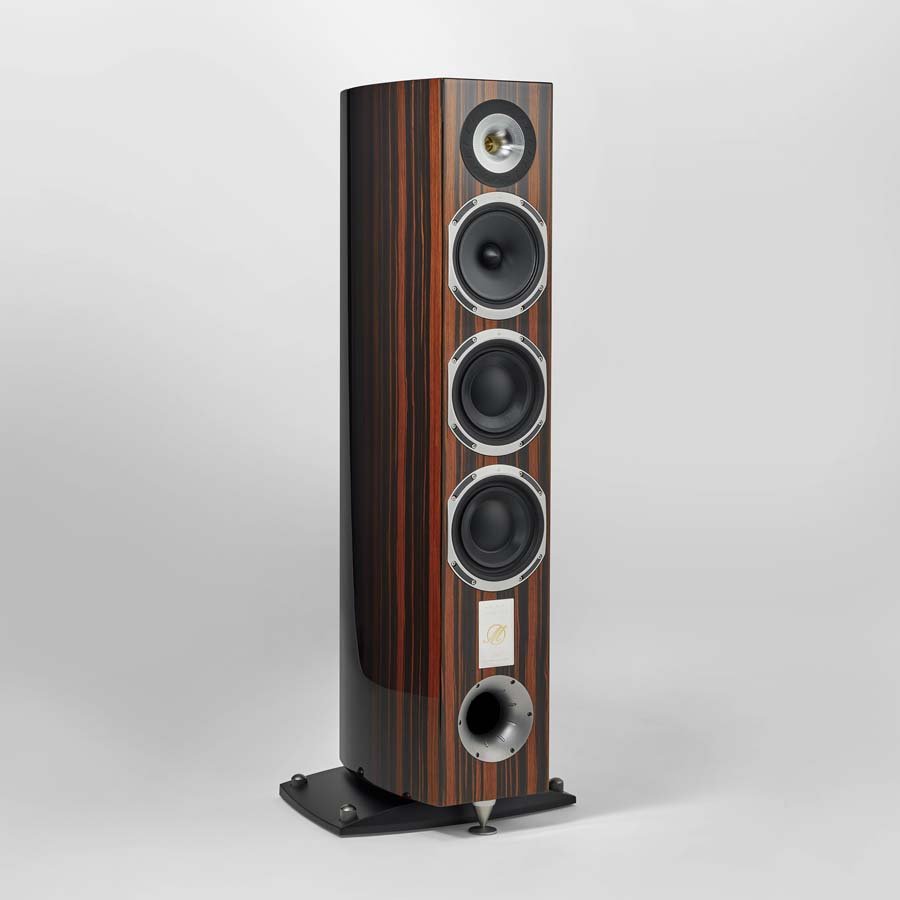
The base plate is curved around a large metal spike/cone (sitting on an integrated ´disc´ to avoid damaging the floor underneath it) that is screwed into the speaker itself towards the front and normally has four rubber feet. This configuration, with most of the weight of the speaker, concentrated on that single ´spike´, more or less works like a tripod and gives ample stability plus a defined termination path for resonances with the metal base, covered with a layer of polymer, aiming to isolate the speaker from the floor. The rubber feet can be replaced with some turned alloy thingies from the wooden box, which also allows for fine adjustment of the speaker´s stance.
As we don´t live in a palace and our living room must perform several functions in addition to being a testing ground for HiFi gear, the speaker and listening seat placement amounted to what I would say were ´semi-nearfield conditions´ with the Cellos sitting relatively close to the wall behind it, but far from the side walls, no more than two metres or six foot and a half apart with the listening seat being about the same distance to the speakers, or very slightly more. With the speakers toed-in to the extent that they are aiming pretty much straight at the listener, this successfully dials out a lot of the peculiarities of the room acoustics, but draws rather more attention to any foibles present in the speakers themselves, most notably regarding driver integration. The Triangles passed with flying colours despite being an array of four drivers (and a rather sizeable bass port) mounted vertically on the baffle, giving a well-integrated presentation from top to bottom of the frequency spectrum.
This is not surprising given that what we have here is essentially a two-way monitor, with the lower two drivers essentially acting as low-frequency reinforcement, the ´midrange´ unit going all the way down to 70 Hz. At the upper end of its range, it crosses over to the high-frequency unit at about 4 kHz, which means all of the range of both male and female vocals is being covered with one and the same unit, which couples a cellulose (i.e. very stable paper) membrane to a relatively tightly ´sprung´ textile surround, a polypropylene, latex-damped, ´phase plug´ in the middle and a really strong motor system. Moreover, instead of burdening this powerful and efficient midrange unit with additional crossover parts to bring its output in line with that of the high-frequency unit, Triangle provided the latter with a carefully calculated horn which helps to harmonise its output and dispersion pattern with the midrange unit. This in turn means, the passive crossover filter could be far more simply and elegantly designed than that in most three-way systems. The cabinet construction is a marvel of very considered internal architecture out of high-density fibreboard – if it were made out of solid wood, it would probably be impossible to lift for a single person – aimed at providing a termination path for resonances away from the drivers, rather than to dampen the life out of it.
SOUND QUALITY
All of which goes a long way to explain the lively, open and detailed presentation the Triangles gave in our listening room. If I were to describe the Magellan Cello 40th Anniversaries with just one word, it would probably be ´generous´. This is not the sort of speaker that holds back for fear it could stray from the ideal of being ´neutral´ or ´accurate´ – more one that focuses on giving the listener all of the beauty and emotion of the music played, come hell or high water. I mostly used the Cellos with a relatively modest, somewhat older Copland CSA 28 hybrid integrated amp, which, nevertheless, formed a mutually beneficial relationship with the Triangles, an Acoustic Signature Challenger Mk III turntable with two motors and eight ´Silencers´ inserted in its 12 kg platter (both factory options), an Acoustic Signature TA-1000 tonearm and Hana ML cartridge either using the amplifier´s integral MM phono stage with a modified Audio Innovations Series 800 step-up transformer or a Trichord Neo phono stage with CM-PSU power supply unit on one of the Copland´s line level inputs. Given the easy load the Triangles present to the amplifier and the favourable listening conditions for low power amplification, my Audio Note Quest (low gain version) 300B single ended triode monoblocks were also tried with my custom Pink Faun Tube Pre line preamp. A Rotel RCD-1570 CD-player was on stand-by as a sidekick to the analogue rig, other equipment present during the test included a Lumin U2 streaming front end and Line Magnetic LM 32 DAC digital/analogue converter.
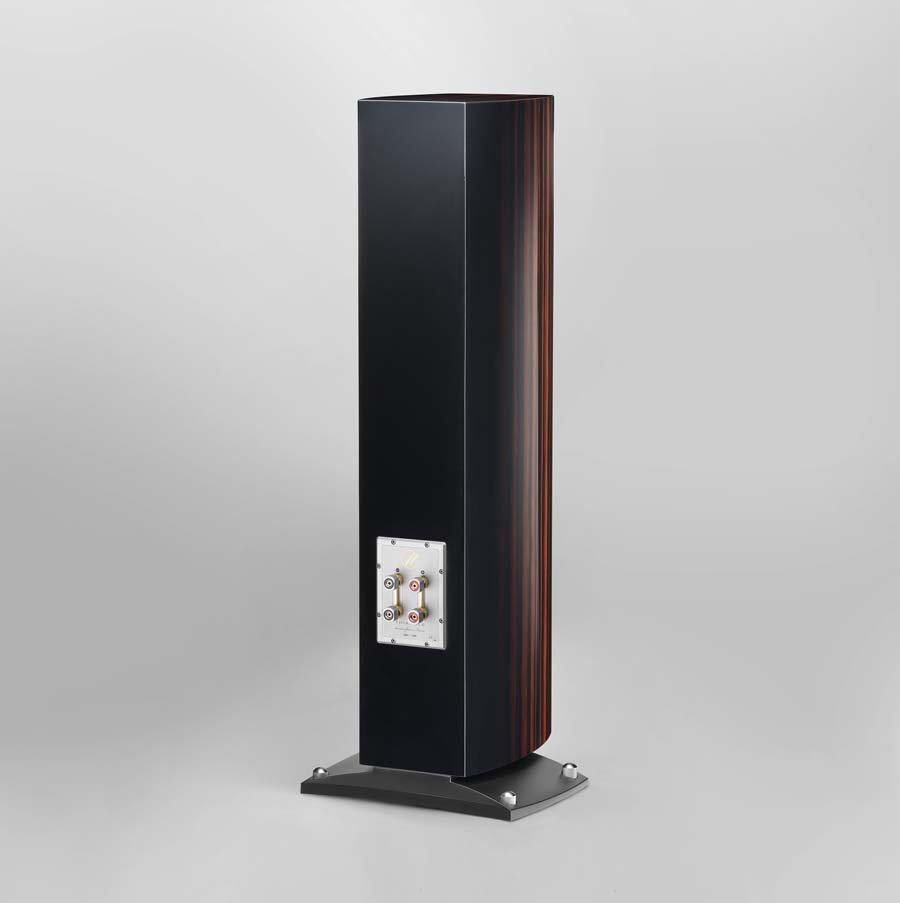
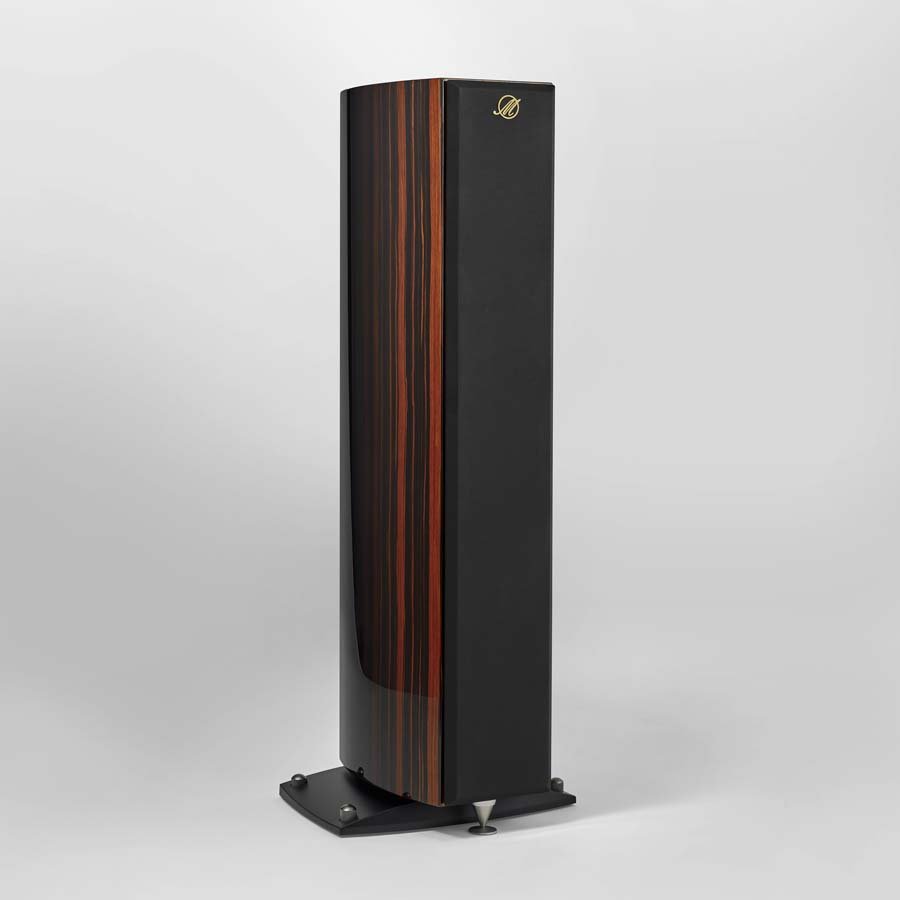
The bass section consists of a pair of 16.5 cm /6.5” woofers – the same diameter as the midrange unit – of which the membranes are of a cellulose honeycomb structure, reinforced with layers of glass fibre on either side. All drivers in the Magellan Cello are equipped with a ‘heat transmission ring’ that thermally couples the magnet polepiece and yoke to the diecast alloy rear section of the basket. This is called the ´LHS2 system´ and why Triangle has the confidence to rate the Magellan Cello’s power handling capacity at up to 300W. Not that it needs such hefty power to give its best – I felt its 90 dB/W/M sensitivity rating, if anything, to be on the conservative side and the Copland´s 60 Watts rating provided more than ample headroom under the given conditions. With -3 dB points being quoted by the manufacturer as 35 Hz and 30 kHz, for all intents and purposes the Cellos can be regarded as a true ´full range´ speaker. The Cellos are designed for room sizes from 25 square metres upwards, and they certainly have the dynamic prowess to energize rooms much bigger than that. We suspect those few who has the disposal of a listening room large enough for the Cellos to find the outer edge of their dynamic envelope, will be looking at 110,000 euro or even 1.1-million-euro speakers, rather than 11,000-euro ones…
The Triangle´s most outstanding feature lies in its sophisticated, expressive and engaging midrange which really draws you into the performance. All-time classics like Joy Division´s Unknown Pleasures get all the brooding intensity they deserve, with Ian Curtis´ voice which has been manipulated and distorted in many ways – including singing through a telephone line! – and the unique sense of space that producer Martin Hannett created on this album – which is both sparse and wide open, with very directly recorded elements verging on the oppressive inside it – sending shivers through one´s spine. Substituting the Pink Faun/Audio Note valve pre/power combo for the Copland amplifier not only brough a richer tonality, but moreover, further opened up the sound stage, lowering the noise floor to reveal subtle dynamic shadings that hitherto had been flying under the radar, while incurring no discernible penalty in bass control or overall dynamics. If anything, the sound seemed more dynamic despite the Quests being rated at a piffling nine watts per channel. We expected a French speaker to work well with Air and Daft Punk, and playing their signature albums Moon Safari and Homework, we were certainly not disappointed, the Triangles separating the layers in Da Funk to reveal a surprising level of sophistication in the production, but not so to surgically dissect it, centring attention at the groove and overall vibe. Kraftwerk´s Computer World (2009 remaster version) also was a delight, leading to reappraisal of this classic album that I always considered to be a bit of a bridesmaid next to its predecessors The Man-Machine and Trans-Europe Express.
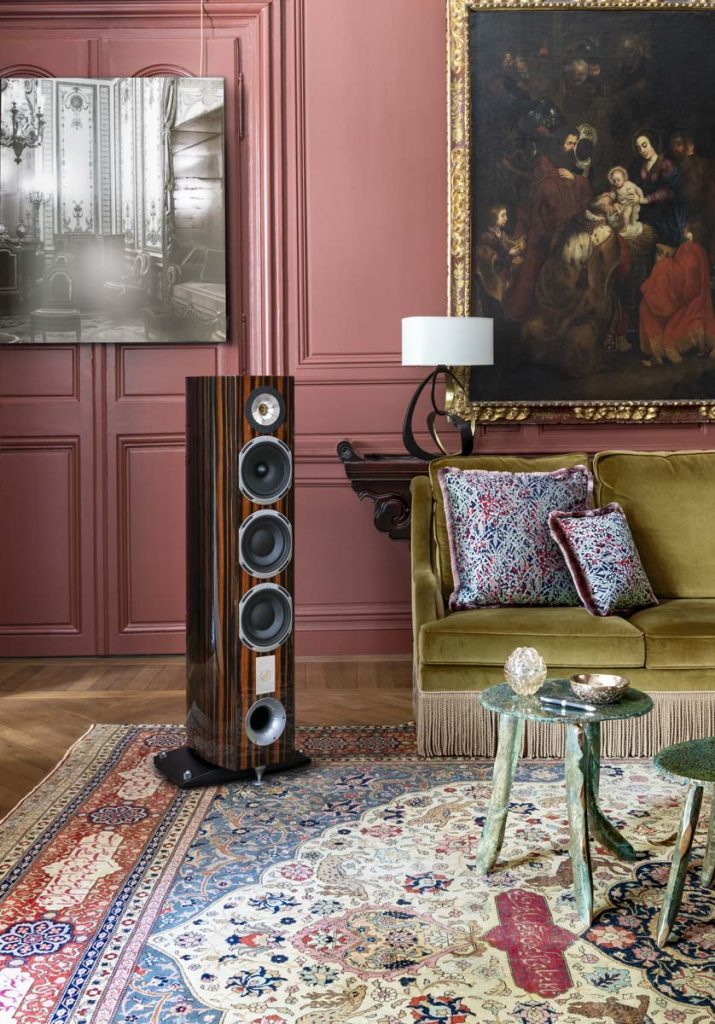
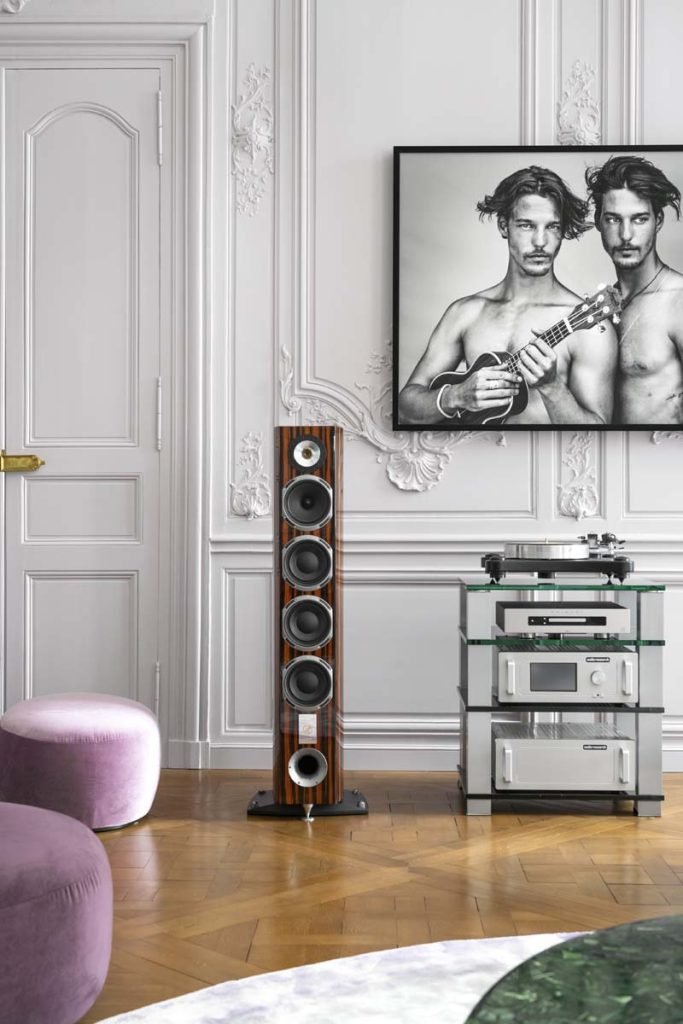
Being configured with a low gain structure to work with speakers of far higher sensitivity than the Triangles (i.e. horns), I feared I would run out of attainable sound pressure levels, but in our moderately sized room and being seated quite close to the speakers, this proved to be more than sufficient. In more normal listening conditions for large column-type speakers, we would certainly advise to ´try before you buy´!
Going from the midrange, both ends of the frequency spectrum were seamlessly integrated with it and kept up very well – the treble being airy and detailed without a hint of aggressiveness and the bass strong, tuneful and well-controlled. This is, however, not a speaker that seeks to impress with fireworks on certain programme material which is often used for demonstration purposes – rather than that, it connects and engages and sucks you into the music.
AT A GLANCE
Build Quality and Features:
Lavishly constructed and finished to an exquisite standard, the Magellan Cello 40th Anniversaries embody ´pride of ownership´ down to the last detail
Sound quality:
Highly engaging, lively and detailed without being surgically dissecting, these are a joyful and generous experience with any style of music you want to feed them
In essence, they offer the immediacy and microdynamics of a very high quality, simple, high-efficiency two-way system with the full range bandwidth and effortless grandeur of a large, multi-driver flagship speaker
Value for money
12,000 euro/£11,000 is a lot of money in virtually anyone´s book, but in this case, it´s very obvious where the money went. Also, the Cellos don´t need a lot of amplifier to reveal their full sonic beauty, so the total system cost can be very reasonable whilst still doing them full justice
We loved:
The overall presentation of the product indicates that the manufacturer is very proud of their flagship range of speakers and wants you to have the best experience possible from them
The Zebrano wood finish with twelve layers of hand-polished lacquer, the very solid speaker terminals and the clever speaker base
The ease of drive – we certainly didn´t expect them to work that well with a single-ended 300B amp
The deeply engaging, lively and smooth musicality which ´opens up´ any kind of music and any recording to the listener
We Didn´t Love So Much:
Well, they´re not exactly ´reduce to the max´ visually so could be a bit of a muchness in some environments (you can tone it down by installing the cloth grilles provided, but that does come with a small penalty, sonically).
Elevator Pitch Review: The second-largest member of the flagship Magellan 40th Anniversary series, the Cello is a floorstanding three-way speaker with a difference – its 165 mm midrange driver covers a full four octaves on the heart of the musical spectrum with a horn-loaded dome tweeter needing no adjustments to the output level of either, which in turn allows the crossover filter to be very simply and elegantly designed. This results in a supremely integrated, immediate and engaging overall sound while at the same time providing the gravitas and effortless dynamics expected from a speaker of this calibre. It is also lavishly constructed and finished to an impeccable standard. The Zebrano wood finish is exceptional; however, the Cello is also available in high gloss black or high gloss white. The production run is limited to 500 pairs, and apparently, if you buy one you get a numbered bottle of champagne to go with it…
Price: 11,000 Euros, £11,000, $15,000

Eric van Spelde
SUPPLIED SPECIFICATIONS
Three-way, ported system: horn-loaded dome tweeter, 165 mm midrange driver, 2 x 165 mm bass drivers
Size (W x H x D): 42,5 x 114 x 37 cm
Weight: 39 kgs
Warranty: 5 years
Sensitivity: 90 dB/W/m
Impedance rating: 8 Ohm (minimum ca. 3.5 Ohm)
















































